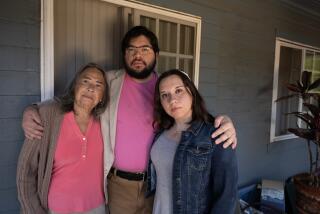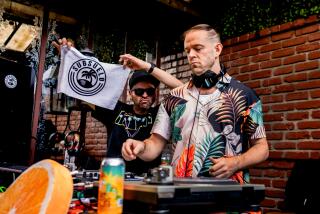REGIONAL REPORT : Hidden Hot Spots : Underground Parties Try to Stay One Step Ahead of the Law
Hundreds of young people pour into the abandoned warehouse, its insides eerily aglow with fluorescent pink and green graffiti. Rotating rays of red, green and yellow light slash the air as dancers gyrate to music pounding from oversize speakers.
Near the disc jockey, a girl glides back and forth on a swing. Across the cavernous room, a gutted school bus--spray-painted with neon-colored scribbles--rocks to the rhythm of the music as more dancers romp inside.
Welcome to “Crunch,” an underground nightclub. It has not been easy to get here. Party-goers, who paid $20 a ticket, had to follow coded directions to find the secret warehouse in a run-down industrial neighborhood in South Los Angeles. There, beyond a pried-apart fence and a dark alley strewn with dumpsters, trash and broken glass, a party with 1960s-style decor and 1990s “acid house” dance music beckoned.
It would not beckon long. Within an hour, Los Angeles police found the gathering and shut it down, sending everyone home or scurrying to find another party.
Call them underground parties, call them roving nightclubs, call them “raves.” Los Angeles police and fire officials call them illegal and say they are potential firetraps that violate a host of laws. Although some have been staged legally elsewhere in Southern California, the underground clubs in Los Angeles often lack zoning and dance permits, serve alcohol to minors, are havens for drug use, take over warehouses or other buildings without permission from property owners, and sometimes leave behind thousands of dollars in damage, authorities say.
“Some, frankly, are dangerous,” said Sgt. Richard Rudell, who is in charge of permit processing at the Los Angeles Police Commission’s investigation division. “There are no sanitation facilities, no regulation as to what people bring in and out. People bring in drugs and booze and all kinds of things. They are not to the benefit of kids.”
In the last year, police, fire and state Alcoholic Beverage Control officials have joined forces to shut down the clubs in Los Angeles. After the March, 1990, fire that killed 87 at an illegal club in New York, Los Angeles Mayor Tom Bradley told the agencies to form a task force to coordinate crackdown efforts, said Sgt. John Fletcher, vice enforcement coordinator’s aide. “The mayor did not want something similar to occur in Los Angeles,” Fletcher said.
But the clubs’ promoters argue that they are merely offering entertainment that young people want--dance parties with cutting-edge, high-energy music that can’t be found on the radio or in regular commercial clubs.
“It’s the music that draws these people,” said Les Borsai, a former underground club promoter, now on probation after arrests at two of his events. “We’ve tried to put on legal shows. If there was a way to do it, we’d do it. It’s not the illegal aspect that draws. It’s the atmosphere we create.”
Underground clubs first gained a following several years ago in London, then spread to New York, Detroit and Chicago, promoters said.
In Southern California, a few clubs can be found in San Diego, where promoters stage them legally, obtaining permits and finding approved buildings for the events, popular with the college crowds there. In Orange County, Borsai staged a legal club in an old ice house in Fullerton a few years ago--police officers even were hired for the event--and underground-style events are put on occasionally at established nightclubs in the county that on other nights play different kinds of music.
But in the Southland, urban Los Angeles is the biggest draw for the avant-garde entertainment. Party-goers reportedly come from as far as Orange County, Ventura and beyond every weekend to Los Angeles, where promoters contend there are few legal dance halls to rent that are large enough to house the huge crowds. Furthermore, the attraction of the underground scene is its diversity and creativity, they say. Staging events in established halls and clubs stifles that, said one promoter who asked not to be identified.
“We have to make it new and different every time. In San Diego, they can do it in the same place because they don’t do it very often,” he said. “Here, if we do the same thing every time, it becomes like a regular club. And that’s not what the underground clubs are about.”
If Los Angeles is the hot spot for underground clubs, though, the fire, police and state Alcoholic Beverage Control authorities are trying to cool it off.
Patrol officers, particularly in the Hollywood, Newton, Central and Rampart divisions, watch for signs of people converging late at night in warehouse districts, then call for help from the Fire Department or close them down themselves, Fletcher said. In addition, “we have people who call and tell us. . . . The average citizen finds out about them too. They don’t want kids ending up in tragic circumstances. There is a real potential for disaster.”
Vernon, a city full of warehouses, has been the scene of three underground parties, police there say. They shut down one, stopped another before it got under way, and learned about a third after it happened. In all three cases, the warehouses were entered illegally, police said. Two promoters--Borsai acknowledges he was one--were arrested and an investigation is continuing, Vernon Police Sgt. Solomon Benudiz said.
Benudiz laughs at the suggestion that the parties are harmless. “They’re vandalizing someone else’s property and bringing in hundreds of teen-agers. They trash a place and they’re not harming anyone? No one dies, sure, but they’re not harmless.”
But party-goers--most in their early 20s and late teens--at two clubs downplayed officials’ concerns about their safety.
“They don’t care about that. They care that this is out-of-control youthful energy. That’s what scares them,” said Raymond Roker, standing outside an underground party dubbed “Get Wet,” staged in an old dance hall south of downtown.
A building at Washington Boulevard and Oak Street--with an old, 1940s-era sign out front proclaiming “Dancing Tonite” is a popular location for underground clubs, said Dan Toomey, supervising investigator in Alcoholic Beverage Control’s Los Angeles office. “We’ve taken that one down several times.” At a recent party, the aroma of marijuana was in the air and one person in a restroom was sniffing white powder. Cups of beer sold for $1, despite the lack of a liquor license. “Ecstasy,” a designer drug, also is reported to be available at such parties. But party-goers say that they do not come for drinks or drugs.
“We come to dance in an environment full of energy. The attraction is the music and the people,” added Jason Bentley, 20, of Los Angeles as he watched dancers at the party. As he spoke, three “loops”--short strips of art films played over and over--were projected onto a wall, showing different angles of a woman swimming nude. Bentley said he is aware of the authorities’ concerns about the parties, “and I respect their interest. But there is too much bureaucracy in a legitimate party. People are willing to sacrifice that for a good time,” he said. Dancing at the underground clubs in the 1990s, he said, “is like racing cars in the ‘50s.”
In Los Angeles, party-goers learn about the clubs through flyers--many with visual references to drugs and advertising party names such as “Big Top Mickey” and “Global Brain.”
“There’s really an excitement to the clubs and part of the allure is getting there,” said one disc jockey, who asked not to be identified. “You get a flyer. You have to call a number. You have to go to a map point. You may have to go to another map point. It’s really adventuresome. But it’s become that way for a reason, because it is necessary.”
(Despite the use of flyers, underground clubs are different from “flyer parties,” which generally are less sophisticated gatherings staged by high school students in the parking lots of industrial areas or in the homes of parents who are away. Students staging the “flyer parties” or “drop parties” usually get a keg of beer and attract large groups of teen-agers by circulating photocopied flyers, police in several cities said.)
In San Diego, the underground scene is smaller. The clubs are legal, although they still are called “underground,” because “they cater to the non-Top 40 market,” said Todd Zweig, a promoter who stages large dance clubs he dubs Plays-cool a couple times a year in the city’s sports arena. He also regularly stages a weekly, smaller event, called “Romper Room,” by renting out a local, established nightclub.
His and other underground clubs in San Diego are legal “basically because I got busted once and it’s not a pleasant experience. And because San Diego is so small. People won’t drive far away, and there isn’t an area in the downtown where the cops wouldn’t find you.”
Former club promoter Borsai said he has tried to put on legal clubs in Los Angeles, but the rules, restrictions and permits involved “create a Catch-22,” he said.
For example, he once tried to put on a legal dance inside a tent downtown. But although a dance permit can be obtained for one night, the zoning change required is permanent, he said.
Likewise, he said, a promoter should be able to stage a party in a warehouse legally, satisfying fire and building safety and other concerns by choosing a place with enough doors, by illuminating exits, bringing in portable toilets and making other changes. “But we get an uncooperative response from the police,” Borsai said.
“The police are determined to catch you some way or the other,” added another promoter.
That’s because warehouses and tents are inappropriate places for large dances catering to teen-agers and young adults, especially if they are located in unsafe areas, police respond.
Meanwhile, at “Crunch,” the colored lights suddenly go black and the music stops. It is only 12:30 a.m., but the party is over. The police have arrived. The violations? They are numerous, a sergeant says, but topping the list is the promoters’ failure to obtain permission from the warehouse’s owner--the state of California. Not to mention the danger of cramming hundreds of people in a dark room with only one exit, police said.
Many of those party-goers head back to a dance hall near Culver City, the same place they had picked up their maps earlier, heeding the last line of the coded directions to “Crunch”: “Return here if it gets busted.”
Others, however, go to “Get Wet.” But even there, a few people decide they don’t want to dance until dawn.
Says a 29-year-old man at his first underground party, getting up to leave, “I’m too old for this.”
More to Read
Sign up for Essential California
The most important California stories and recommendations in your inbox every morning.
You may occasionally receive promotional content from the Los Angeles Times.










